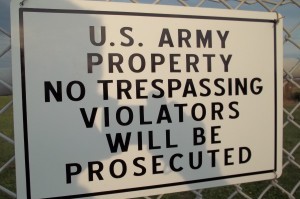 The legislation known as RCRA (the Resource Conservation and Recovery Act) was passed in 1976, with regulations being enacted by the US EPA in 1980. For the longest time, it was uncertain if the RCRA regulations applied to Federal facilities. Some cited sovereign immunity to claim that they need not follow the RCRA regulations in managing their hazardous waste. Others, voluntarily complied with RCRA in a haphazard way that made enforcement difficult.
The legislation known as RCRA (the Resource Conservation and Recovery Act) was passed in 1976, with regulations being enacted by the US EPA in 1980. For the longest time, it was uncertain if the RCRA regulations applied to Federal facilities. Some cited sovereign immunity to claim that they need not follow the RCRA regulations in managing their hazardous waste. Others, voluntarily complied with RCRA in a haphazard way that made enforcement difficult.
To clear up this confusion, FFCA (the Federal Facilities Compliance Act) was passed in 1992. It required federal facilities (those within the Executive branch of the US Government) to comply with the RCRA regulations enforced by federal, state, or local authorities or face civil and criminal penalties. Federal facilities includes the US Armed Services, which resulted in waste generated by the military, including military munitions, becoming subject to RCRA regulations. Confusion about the exact management requirements of military munitions under RCRA continued, however, until the passage of the Military Munitions Rule in 1997. This rule clarified the point of generation of solid and hazardous waste for military munitions and who is subject to the regulations.
The rule created a definition of military munitions, found at 40 CFR 260.10:
Military munitions means all ammunition products and components produced or used by or for the U.S. Department of Defense or the U.S. Armed Services for national defense and security, including military munitions under the control of the Department of Defense, the U.S. Coast Guard, the U.S. Department of Energy (DOE), and National Guard personnel. The term military munitions includes: confined gaseous, liquid, and solid propellants, explosives, pyrotechnics, chemical and riot control agents, smokes, and incendiaries used by DOD components, including bulk explosives and chemical warfare agents, chemical munitions, rockets, guided and ballistic missiles, bombs, warheads, mortar rounds, artillery ammunition, small arms ammunition, grenades, mines, torpedoes, depth charges, cluster munitions and dispensers, demolition charges, and devices and components thereof. Military munitions do not include wholly inert items, improvised explosive devices, and nuclear weapons, nuclear devices, and nuclear components thereof. However, the term does include non-nuclear components of nuclear devices, managed under DOE’s nuclear weapons program after all required sanitization operations under the Atomic Energy Act of 1954, as amended, have been completed.
Note the list of materials that the term military munitions includes, and doesn’t include (note my emphasis added to the above). Also, be aware that the rule applies not only to the military, but to contractors or other parties acting as their agent.
Further, the rule amended §261.2(a)(2) to include military munitions identified as a solid waste per §266.202 as a 4th type of discarded material. This is important, because in order to be a hazardous waste, and therefore subject to Cradle to Grave regulation, it must first be a solid waste. The identification of a solid waste starts you on the path toward determination of a hazardous waste, if exemptions apply, and what regulations with which you must comply.
So, when is a military munition a solid waste?
The RCRA regulations at §266.202 (§266, Subpart M) identifies the status of four activities involving military munitions and whether or not they are a solid waste:
- SOLID WASTE: Unused munitions designated for disposal; these include:
- Munitions that have been or are being disposed, burned, or otherwise treated prior to disposal [§266.202(b)(1)].
- Munitions removed from storage for the purpose of being disposed, burned, or otherwise treated prior to disposal [§266.202(b)(2)].
- Leaking or deteriorated munitions [§266.202(b)(3)].
- When an authorized military official declares the munitions to be a solid waste [§266.202(b)(4)].
- NOT SOLID WASTE: Unused munitions that are disassembled, repaired, or otherwise recovered [§266.202(a)(2)].
- NOT SOLID WASTE: Munitions used for training, research and development, or evaluation. If used for its intended purpose, it is not a solid waste. The regulations cite two situations where this condition applies:
- Military training exercises [§266.202(a)(1)(i)].
- Weapons testing, research and development, or evaluation [§266.202(a)(1(ii)].
- NOT SOLID WASTE: Range clearance operations that take place on-range at active or inactive sites [§266.202(a)(1)(iii)]. SOLID WASTE: Military munitions shipped off-range for treatment or disposal for range clearance operations.
The Federal Facilities Compliance Act (FFCA) of 1992 expanded the reach of RCRA to include federal facilities within the Executive branch of the US government. If you are a commercial or industrial facility, you were already subject to the Resource Conservation and Recovery Act and compliance with these regulations is not an option. The RCRA regulations require generators of hazardous waste to train their Facility Personnel who need to know the regulations in order to do their job safely and in compliance with the regulations. Contact me to determine the type of training that is right for you.

